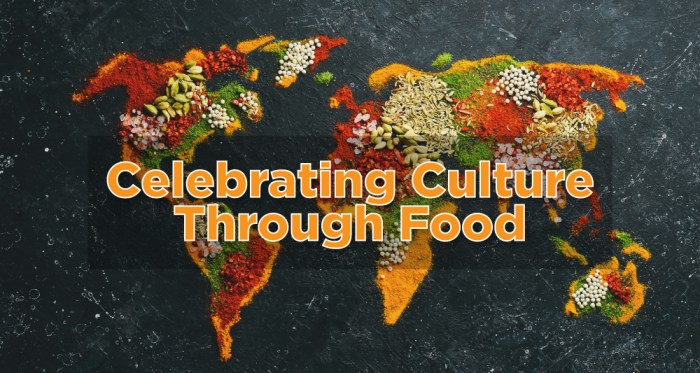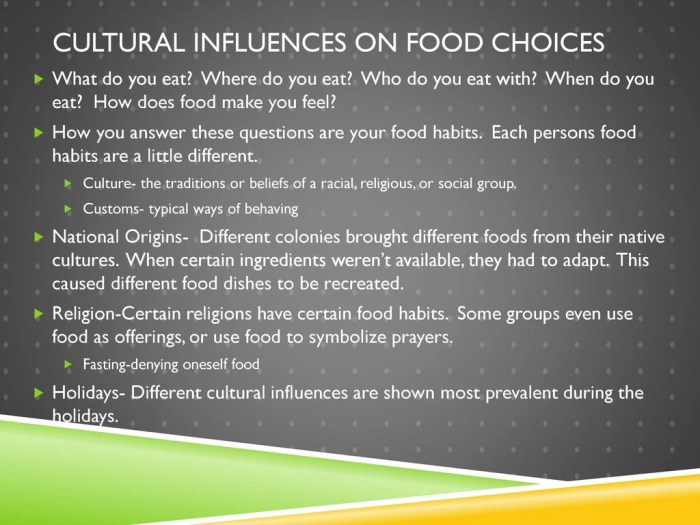
Cultural Impact on Culinary Practices: Influence Of Culture On Food Traditions

Influence of culture on food traditions – Culture exerts a profound influence on culinary practices, shaping food preparation, consumption, and dietary choices. Beliefs, values, religion, ethnicity, and social norms play significant roles in determining what people eat, how they cook it, and the significance they attach to food.
Religious Influence
- Many religions have dietary restrictions and guidelines that guide the food choices of their followers. For example, Muslims abstain from pork and alcohol, while Hindus avoid beef.
- Religious festivals and holidays often feature specific dishes that hold cultural and symbolic importance. For instance, the Jewish Passover meal includes unleavened bread and bitter herbs.
Ethnic and Regional Variations
- Culinary traditions vary widely across different ethnic groups and regions. Factors such as climate, geography, and availability of ingredients contribute to the development of distinct cuisines.
- For example, the Mediterranean diet emphasizes fresh produce, seafood, and olive oil, while the Chinese cuisine is known for its use of soy sauce, ginger, and garlic.
Social Norms and Food Habits
- Social norms and customs influence food consumption patterns. In some cultures, certain foods are considered taboo or inappropriate for specific occasions or individuals.
- For instance, in some Asian cultures, it is considered rude to eat with one’s hands, while in many Western cultures, using cutlery is the norm.
Regional Variations and Influences
The culinary traditions of a region are not static but rather dynamic and ever-evolving, influenced by a myriad of factors. Geography and climate play a significant role in shaping the availability and use of ingredients, while trade and migration facilitate the exchange of culinary ideas and techniques, leading to the emergence of regional cuisines with their own distinctive characteristics.
Impact of Geography and Climate
The physical landscape and climate of a region exert a profound influence on its food traditions. Arid regions, with limited access to water, often rely on drought-resistant crops such as grains and legumes, while coastal areas have a wider variety of seafood and other aquatic resources. Temperate climates favor the cultivation of a wide range of fruits and vegetables, while tropical regions boast an abundance of exotic fruits and spices.
Role of Trade and Migration
Trade and migration have played a crucial role in the dissemination of culinary ideas and techniques across cultures. Merchants and travelers have carried spices, ingredients, and cooking methods from one region to another, leading to the adoption and adaptation of new flavors and dishes. For example, the introduction of chili peppers from the Americas to Europe in the 16th century revolutionized European cuisine.
Emergence of Regional Cuisines
The interplay of geography, climate, trade, and migration has given rise to a diverse array of regional cuisines around the world. Each region has its own unique culinary identity, characterized by the use of specific ingredients, cooking techniques, and flavors. For instance, Mediterranean cuisine is known for its use of olive oil, fresh vegetables, and herbs, while Southeast Asian cuisine is renowned for its bold flavors and use of spices.
Cross-Cultural Influences and Adaptations
Culinary traditions are not static entities; they evolve and change as cultures interact and exchange ideas. This process of cultural borrowing and fusion has resulted in a rich tapestry of culinary traditions worldwide.
One of the most famous examples of cultural borrowing is the introduction of tomatoes to Europe from the Americas. Tomatoes were initially grown as ornamental plants, but they eventually found their way into kitchens, where they quickly became a staple ingredient in many dishes.
Another example of cultural fusion is the development of Tex-Mex cuisine in the United States. Tex-Mex cuisine combines elements of Mexican and American cuisine, resulting in dishes such as tacos, burritos, and nachos.
The Process of Adaptation and Modification
The process of cultural borrowing and fusion is not always straightforward. When cultures interact, they often adapt and modify the culinary traditions they borrow from other cultures to suit their own tastes and preferences.
For example, when tomatoes were introduced to Europe, they were initially used in small quantities due to their strong flavor. Over time, however, Europeans developed a taste for tomatoes, and they eventually became a staple ingredient in many dishes.
Similarly, Tex-Mex cuisine has evolved over time to reflect the tastes and preferences of American consumers. For example, Tex-Mex dishes are often made with more cheese and ground beef than traditional Mexican dishes.
The Impact of Globalization and Technology
Globalization and technology have played a significant role in the spread of culinary influences. In the past, the spread of culinary traditions was limited by geographical barriers. However, with the advent of globalization and technology, it is now possible for people to access culinary traditions from all over the world.
For example, the internet has made it possible for people to find recipes and cooking tips from all over the world. Additionally, the growth of international travel has allowed people to experience different culinary traditions firsthand.
Contemporary Trends and Innovations

Contemporary food culture is shaped by a confluence of factors, including growing health consciousness, sustainability concerns, and cultural diversity. Technology and social media play an increasingly influential role in shaping food preferences and culinary practices.
Emerging Trends
- Health-Conscious Eating: Consumers are increasingly seeking out nutritious and wholesome foods, leading to a rise in plant-based diets, whole grains, and minimally processed ingredients.
- Sustainability: Environmental concerns are driving a shift towards sustainable food practices, including reduced meat consumption, local sourcing, and minimizing food waste.
- Cultural Diversity: Globalization has brought a wide range of cuisines and ingredients to the forefront, fostering cultural exchange and experimentation in food.
Role of Technology and Social Media
Technology and social media have revolutionized the way we interact with food. Online recipe sharing, food photography, and social media platforms have made it easier to discover new cuisines, connect with chefs, and share culinary experiences.
Food Tourism and Culinary Experiences, Influence of culture on food traditions
Food tourism is on the rise, as travelers seek out unique and authentic culinary experiences. Local food markets, cooking classes, and farm-to-table dining offer opportunities to engage with food cultures and learn about local traditions.